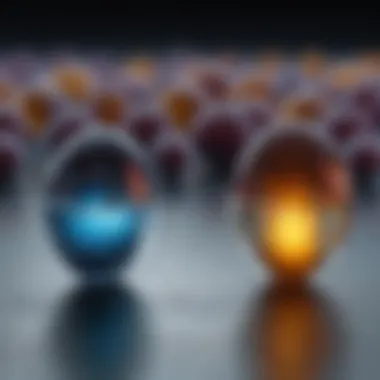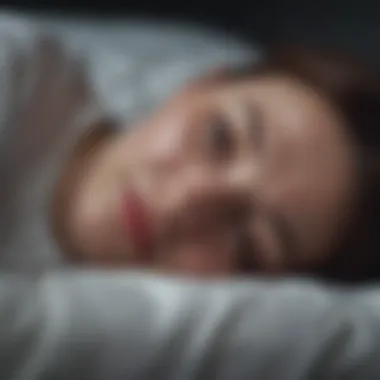Melatonin and Light: An In-Depth Exploration


Intro
The interplay between melatonin and light is a fundamental aspect of sleep and circadian rhythms. Melatonin, often called the sleep hormone, plays a crucial role in regulating sleep patterns among humans and other organisms. Light exposure significantly affects the production of this hormone. The rise and fall of light throughout the day can signal our body when to be awake and when to rest. This relationship is not just interesting; it holds significant implications for health, wellness, and various sleep-related disorders.
In this exploration, we will delve into the biochemical pathways through which melatonin is synthesized, how different light spectra influence melatonin levels, and the potential applications of this knowledge in managing sleep disorders and optimizing circadian rhythms. The following sections will highlight key findings and research that enrich our understanding of this topic, offering insights applicable both in everyday life and clinical practice.
Research Highlights
Key Findings
- Synthesis of Melatonin: The production of melatonin primarily occurs in the pineal gland, regulated by the light-dark cycle. During darkness, melatonin levels rise, promoting sleep. Conversely, exposure to bright light, especially blue light, can inhibit its synthesis.
- Impact of Light Spectra: Not all light affects melatonin production equally. Research indicates that blue light, emitted by screens and artificial lighting, is particularly suppressive of melatonin secretion, while red wavelengths have minimal impact.
- Chronobiological Variations: Individual differences in melatonin response to light exposure may be influenced by factors such as age, genetics, and personal health. This variability is crucial for personalizing treatments for sleep disorders.
- Applications in Sleep Disorders: Understanding the relationship between melatonin and light can inform therapeutic approaches to insomnia, seasonal affective disorder, and shift work sleep disorder. Light therapy and melatonin supplementation are common strategies used in these contexts.
Implications and Applications
- Health and Wellness: Knowledge of melatonin and light dynamics can enhance daily routines. For instance, reducing exposure to screens before bedtime can improve sleep quality.
- Clinical Applications: Clinicians can leverage melatonin's relationship with light to devise more effective treatment plans, utilizing light therapy or melatonin supplements to address sleep issues.
"Understanding how melatonin secretion varies with light exposure opens doors to tailored therapies for sleep disorders."
Methodology Overview
Research Design
To explore these findings, various studies utilized both observational and experimental designs. Researchers measured melatonin levels under controlled light conditions, assessing the hormonal responses to different light spectra.
Experimental Procedures
- Participants: Studies often involved a range of participants differing in age, lifestyle, and health status to analyze how individual characteristics affect melatonin secretion.
- Light Exposure Protocols: Procedures included exposing participants to specific light wavelengths in laboratory settings to monitor changes in melatonin levels at different times such as evening and morning.
- Data Analysis: Researchers employed statistical tools to analyze the relationship between light exposure and melatonin production and to draw conclusions based on their findings.
Through these methodologies, researchers have gained a comprehensive understanding of the biochemical interactions between melatonin and light, paving the way for further research and innovative treatments for sleep-related conditions.
Preamble to Melatonin
Melatonin is a hormone that plays a crucial role in regulating sleep-wake cycles and various physiological processes. Understanding melatonin is essential for grasping its impact on health, especially in the context of modern lifestyles, where artificial lighting often disrupts natural patterns. This section will explore the biochemical structure of melatonin, its significant role in sleep regulation, and how it interacts with circadian rhythms.
Biochemical Structure of Melatonin
Melatonin, chemically known as N-acetyl-5-methoxytryptamine, is a derivative of the amino acid tryptophan. Its structure consists of an indole ring, which is a common feature of several biological molecules, alongside an ethyl side chain. This relatively simple structure allows for its effective function as a hormone. In the human body, melatonin is primarily produced in the pineal gland, located deep within the brain.
The synthesis pathway starts from tryptophan, which is converted into serotonin and then further transformed into melatonin during the night. The production peaks during darkness, which is significant for sleep regulation. By understanding the biochemical structure, one can appreciate how melatonin interacts with receptors to exert its effects on the body.
Role of Melatonin in Sleep Regulation
Melatonin's primary function is to signal the body that it is time to sleep. Its levels typically rise in the evening and fall in the morning, following the natural light-dark cycle. This fluctuation has a direct influence on sleep quality and duration. Melatonin acts on specific receptors, mainly MT1 and MT2, located throughout the brain. These receptors play essential roles in promoting sleep and regulating circadian rhythms.
Disruptions in melatonin production can lead to sleep disorders, insomnia, and other health issues. For example, people who travel across time zones often experience jet lag, attributed to misaligned melatonin levels. Also, those who work night shifts may have a reduced capacity to produce melatonin at appropriate times, leading to irregular sleep patterns.
Circadian Rhythms and Melatonin
Circadian rhythms are the body's internal clock, influencing behavioral and physiological processes within a roughly 24-hour cycle. Melatonin is integral to maintaining these rhythms, primarily by responding to light exposure. During the day, light signals through the retina suppress melatonin secretion. During night time, the absence of light allows melatonin levels to increase, promoting feelings of sleepiness.
The synchronization of these rhythms is vital for good health. Imbalances can lead to various problems, including metabolic syndrome, mood disorders, and weakened immune response. Therefore, recognizing how melatonin aligns with circadian rhythms can inform strategies for improving sleep health and overall well-being.
"Melatonin not only regulates sleep but also influences multiple aspects of health through its role in circadian rhythms."
The Science of Light


The exploration of light and its influence on biological functions is crucial in understanding human physiology, particularly concerning sleep regulation. Light impacts various biological systems, such as hormones, including melatonin. This section emphasizes the significance of light in the context of health and well-being. A solid grasp of the principles of photobiology can inform practices that align lifestyle choices with natural light exposure, possibly improving sleep quality and overall health.
Photobiology: Understanding Light's Effects on Biological Systems
Photobiology is a field that investigates how light interacts with living organisms. One fundamental aspect is how light perception regulates various biological processes. For instance, light influences the production of melatonin, a hormone that plays a vital role in sleep regulation. In the retina, specialized photoreceptor cells detect light and send signals to the brain, particularly to the suprachiasmatic nucleus, which governs circadian rhythms.
These biological rhythms dictate when the body should prepare for sleep and wakefulness. Disruption of this cycle, often caused by inadequate or excessive light exposure, can lead to sleep disorders. It is known that during nighttime, darkness promotes melatonin secretion, signaling to the body that it is time to rest.
"Misalignment of light exposure with natural circadian rhythms can lead to numerous health issues, including insomnia and mood disorders."
Light effects extend beyond sleep. They can influence mood, alertness, and even cognitive functions. For instance, exposure to bright light during the day can enhance alertness and cognitive performance. Understanding these interactions underscores the importance of maintaining a balanced light exposure to support health and wellness.
Different Spectra of Light and Their Biological Impacts
Light does not exist as a single entity; rather, it comprises various spectra, each having distinct effects on biological systems. The two primary categories of light are visible light and non-visible light, which includes ultraviolet and infrared radiation. The visible spectrum ranges from violet to red, with each color having unique biological functions.
Key impacts of different light spectra include:
- Blue Light: Primarily emitted by digital devices, blue light exposure can significantly suppress melatonin production. Consequently, excessive exposure at night can lead to poor sleep quality and difficulties in falling asleep.
- Red Light: This spectrum is less likely to affect melatonin levels and has been found to promote relaxation, making it less disruptive to sleep. Using warm, red-toned lighting in the evening may support better sleep practices.
- Green Light: Emerging studies suggest that green light can help in regulating sleep cycles as well. Its effects are still under research, but it might be beneficial in daylight exposure.
By understanding how different light spectra affect melatonin and overall health, individuals can tailor their environments and habits to improve sleep and well-being.
Melatonin Production and Light Exposure
Understanding the relationship between melatonin production and light exposure is crucial in the exploration of sleep regulation and circadian rhythms. Melatonin, a hormone primarily produced by the pineal gland, plays a significant role in signaling the body's internal clock in response to light conditions. This interaction influences not only sleep patterns but also various physiological processes. In this section, we will discuss how light exposure affects melatonin synthesis, what this means for health, and the implications for modern lifestyles.
Light Perception and Melatonin Suppression
Light perception is essential in regulating melatonin levels. When the retina detects light, it sends signals to the suprachiasmatic nucleus (SCN), which is the master clock of the body. The SCN processes this information and impactsmelatonin production. During daylight or exposure to bright artificial lighting, melatonin production is suppressed. This suppression is vital for maintaining alertness during the day.
Here are key points about light perception and melatonin suppression:
- Mechanism: Light inhibits the enzyme N-acetyltransferase, which is responsible for melatonin synthesis.
- Duration of Exposure: Longer exposure to light affects the timing of melatonin release, which usually peaks during nighttime.
- Importance of Darkness: Darkness plays a critical role in allowing melatonin levels to rise, preparing the body for sleep.
"A consistent exposure to light in the evening can significantly delay melatonin secretion, thus disrupting the sleep-wake cycle."
This relationship emphasizes the need for individuals, especially those with irregular schedules, to consider their light environment in order to promote better sleep quality.
The Role of Blue Light in Melatonin Regulation
The influence of blue light on melatonin regulation cannot be overstated. Blue light, which has a short wavelength, is emitted from screens of smartphones, computers, and LED lighting. This type of light is particularly potent at affecting melatonin levels due to its intensity and wavelength.
Here are critical aspects regarding blue light and melatonin:
- Biological Impact: Blue light exposure, especially in the evening, can delay the natural onset of sleep by inhibiting melatonin production.
- Comparative Analysis: Studies have shown that blue light has a greater impact on melatonin suppression than other light spectra, such as red or yellow light.
- Recommendations: Experts suggest reducing blue light exposure in the hours leading up to bedtime. This can be achieved by using blue light filters on devices or simply dimming lights in living spaces.
As seen, understanding the role of blue light is vital not just for individuals looking to improve their sleep. This knowledge can also guide broader strategies for enhancing public health and well-being by addressing environmental factors that disrupt natural sleep patterns.
Impact of Artificial Light on Melatonin Levels
The impact of artificial light on melatonin levels has increasingly become a central topic in the discussions surrounding sleep hygiene and health. Melatonin, as a hormone profoundly influencing sleep-wake cycles, is sensitive to light exposure, particularly during the evening hours. Understanding this relationship is essential for developing strategies that can help optimize sleep quality and maintain circadian rhythms in a world dominated by artificial lighting.
Artificial lighting disrupts the natural cues provided by sunlight, leading to circadian misalignment. Circadian rhythms, our internal clocks, depend on external light-dark cycles for regulation. When the light from screens or LEDs extends into nighttime, melatonin production can be inhibited. This suppression adversely affects both the timing and quality of sleep. Thus, selectively managing light exposure becomes crucial in promoting better health and wellness.
Artificial Lighting and Circadian Misalignment


The phenomenon of circadian misalignment due to artificial lighting is a pressing concern, as modern living often entails extensive exposure to artificial light sources. Studies show that the blue spectrum light emitted from devices like smartphones and computers is particularly influential in this respect. Such exposure can lead to significant delays in sleep onset, prolonged wakefulness, and altered sleep architecture.
A few key factors to consider include:
- Duration of Exposure: The longer one is exposed to artificial light before sleep, the more pronounced the effects on melatonin suppression.
- Intensity of Light: Bright lights reduce melatonin production more than dim lights.
- Wavelength Sensitivity: Blue light has been identified as specifically damaging to melatonin levels.
Understanding these factors is important for individuals aiming to maintain healthy sleep patterns amidst a backdrop of constant artificial illumination.
Technology Use Before Sleep and Its Consequences
The use of technology before bedtime carries direct implications for sleep quality. With the rise of smartphones, tablets, and computers, individuals often find themselves engaged with screens as they prepare for sleep. This electronic interaction usually leads to increased exposure to artificial lighting, mainly blue light, reducing melatonin levels at a critical time.
Some consequences of technology use before sleep include:
- Difficulty Falling Asleep: The immediate impact of light exposure often leads to decreased melatonin levels, delaying the ability to fall asleep.
- Reduced Sleep Quality: Shortened sleep duration and more awakenings during the night are common consequences.
- Daytime Sleepiness: The residual effects of poor sleep can manifest as increased tiredness during the day, impacting productivity and mood.
Clinical Implications of Melatonin and Light Interaction
The intersection of melatonin and light exposure bears significant clinical implications, particularly in the context of sleep regulation and overall health. Understanding how light modulates melatonin levels provides valuable insights into managing sleep disorders, improving mental health, and enhancing overall well-being. Often overshadowed, these implications are crucial for both clinical practices and everyday life.
Melatonin Supplementation: Efficacy and Applications
The use of melatonin supplements has become increasingly common, particularly as more people seek solutions for sleep challenges. Studies show that melatonin supplementation can be effective in treating conditions like insomnia, especially in individuals with delayed sleep phase disorder. By introducing melatonin externally, the body's rhythm can be reset, promoting better sleep quality and duration.
However, the effectiveness of melatonin can vary significantly among individuals. Factors such as age, underlying health conditions, and light exposure play a role in how well supplementation works. Generally, short-term use of melatonin appears to be safe, but long-term effects are less understood. Thus, it is advisable to consult a healthcare professional before starting supplementation, especially for children or those who are pregnant.
Some applications of melatonin supplementation in clinical settings include:
- Managing jet lag.
- Assisting shift workers in aligning their sleep-wake cycles.
- Aiding the elderly, whose natural melatonin production may diminish with age.
Melatonin supplementation has shown promise, but personalized approaches are essential for efficacy.
Light Therapy for Sleep Disorders
Light therapy is another significant avenue emerging from the melatonin-light interaction. This therapy typically involves exposure to bright light at specific times during the day to correct circadian misalignments. By strategically applying light in a controlled environment, clinicians can help patients reset their internal clocks, thereby improving their sleep disorders and associated health issues.
Research indicates that light therapy is particularly beneficial for individuals with Seasonal Affective Disorder (SAD) and other mood disorders that correlate with disruptions in circadian rhythms. The bright light exposure mimics natural sunlight, which has been shown to elevate mood and increase alertness. This method can also support the treatment of sleep phase disorders by enhancing light's positive effects on melatonin suppression.
In practice, light therapy can be administered with:
- Light boxes emitting bright white light
- Dawn simulators that gradually increase light before waking
- Special lamps designed for home use
Light Conditions and Sleep Quality
The relationship between light conditions and sleep quality is crucial for understanding the broader dynamics of melatonin regulation. Sleep is fundamental to overall health, making it clear why investigating factors that disrupt or enhance sleep is important. Natural and artificial lighting can profoundly influence the quality of sleep by affecting melatonin production.
The key elements in discussing light conditions include the type, intensity, and duration of light exposure. Light conditions affect the biological clock, also known as the circadian rhythm, which plays a significant role in governing sleep patterns. Proper management of this relationship can result in better sleep quality and promote well-being.
Benefits of Understanding Light Conditions
- Improved sleep duration and efficiency.
- Better alignment of circadian rhythms.
- Enhanced mood and cognitive function.
Considerations When Managing Light Exposure
- Reducing exposure to artificial light, especially blue light, before bedtime is essential.
- Utilizing dim and warm lighting during the evening can help signal the body to prepare for sleep.
- Ensuring exposure to natural light during the daytime can help maintain a healthy circadian rhythm.


Optimizing Light Environment for Better Sleep
Creating a light environment conducive to sleep is a practical approach to enhancing sleep quality. One effective method includes adjusting light levels based on the time of day. During the day, bright light supports alertness and cognitive function, while at night, lower light levels signal the body to prepare for sleep.
Key Strategies to Optimize Light Environment
- Use of Dim Lighting:
According to studies, dimming lights in the hour leading up to sleep helps in melatonin production. Consider using lamps with soft light bulbs or smart bulbs that can be adjusted. - Blocking Blue Light:
Blue light can hinder melatonin synthesis. Limiting screen time on phones, computers, and TVs before bedtime can have positive effects on sleep. - Light Filters:
Using blue light filters on screens or specialty glasses at night can mitigate negative impacts.
By adjusting these aspects of the light environment, better sleep outcomes can often be achieved.
Influence of Natural Light on Melatonin Levels
Natural light plays an indispensable role in melatonin regulation. Exposure to sunlight during daytime helps maintain the body's natural cycles. This balance is critical for sustaining optimal melatonin levels at night.
Effects of Natural Light on Melatonin
- Boosting Daytime Alertness:
Natural light exposure during the day helps to increase serotonin levels, which later converts to melatonin at night. - Evening Dimming:
As daylight diminishes, the body naturally ramps up melatonin production. Too much artificial light can disrupt this process. - Seasonal Changes:
During the winter months, reduced exposure to sunlight can lead to decreased melatonin production and seasonal affective disorder, emphasizing the need for sufficient natural light.
Understanding how natural light influences melatonin levels is key in promoting good sleep. Awareness of the implications of light exposure supports the adoption of healthier habits.
Future Research Directions
Future research on melatonin and light is essential for multiple reasons. Considered a crucial area of inquiry, it encompasses examining different melatonin-light interaction aspects that remain largely unexplored. As studies evolve, understanding these interactions can lead to optimized therapeutic approaches for sleep disorders and improved overall health outcomes. Investigating these areas could yield significant benefits not only for individuals suffering sleep-related issues but also for enhancing general public health awareness regarding natural circadian rhythm cues.
Unexplored Aspects of Melatonin and Light Interactions
Despite the existing body of research, there are numerous unexplored facets of melatonin and light interactions. These gaps present an opportunity for future studies. For instance, researchers could focus on how various light wavelengths, beyond blue light, affect melatonin secretion.
- Narrowband Lighting: Examination of narrowband technologies and how they influence melatonin under varied conditions could provide insights into light design for optimizing sleep environments.
- Seasonal Variations: Another area includes understanding seasonal impacts on light exposure and consequent melatonin levels. This could inform practices for seasonal affective disorder treatment.
- Individual Differences: Personalized responses to light exposure based on genetic makeup and external factors, such as geographical location, might also warrant deeper exploration.
Such studies can build a comprehensive framework of knowledge, establishing a connection between light exposure patterns and individual melatonin production.
Innovations in Light-Based Therapies
As science progresses, innovations in light-based therapies continue to emerge. Emerging technology presents exciting possibilities for addressing melatonin dysregulation. For instance, light therapy boxes with adjustable spectra may offer targeted solutions for sleep disorders.
Potential innovations include:
- Dynamic Lighting Solutions: Smart lighting systems that adapt according to the time of day can play a role in naturally regulating the body's circadian rhythm.
- Wearable Light Devices: Developments in wearable technologies that emit specific wavelengths of light might assist in improving melatonin secretion before sleep.
- Mobile Applications: Programs designed to simulate natural light exposure through screens that reduce blue light during nighttime could enhance melatonin production in users.
Exploring these advanced therapies will significantly contribute to the understanding of effective strategies for improving sleep quality and overall well-being.
Epilogue
The conclusion of this exploration emphasizes the pivotal relationship between melatonin and light exposure. This article has revealed key insights into how these elements interact and significantly affect sleep patterns, health, and overall well-being.
Summary of Key Findings
Throughout the discussion, several fundamental points emerged:
- Melatonin plays a critical role in regulating sleep, influenced by the body's circadian rhythms.
- Light exposure, particularly the type and timing, can suppress melatonin production, directly impacting sleep quality.
- Blue light from artificial sources poses a significant challenge to natural melatonin cycles, leading to potential sleep disorders.
- Light therapy and melatonin supplementation serve as viable interventions in addressing sleep-related issues.
These findings illustrate the necessity of understanding how light environments can optimize melatonin levels and thus improve sleep quality.
Implications for Daily Life and Public Health
The implications of these insights are broad and pertinent to daily life. Individuals should be aware of their light exposure, especially in the evening. Practical strategies include:
- Limiting screen time before bedtime to reduce blue light impact.
- Utilizing dim, warm lighting at night can enhance melatonin production.
- Engaging with natural light during the day to support circadian rhythms.
From a public health perspective, this knowledge opens avenues for educational programs emphasizing proper light habits. As sleep-related disorders continue to rise, integrating light management into health recommendations could yield substantial benefits.
Ultimately, understanding and optimizing the interplay between melatonin and light are crucial steps toward healthier lifestyles.



